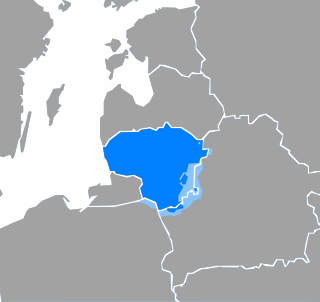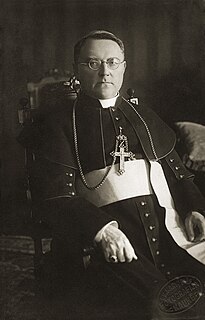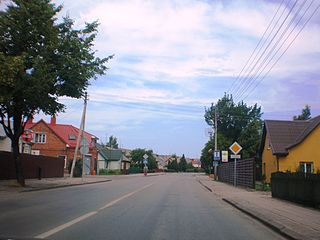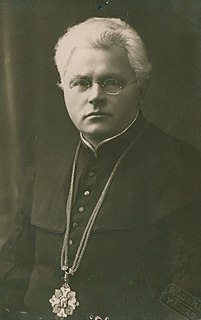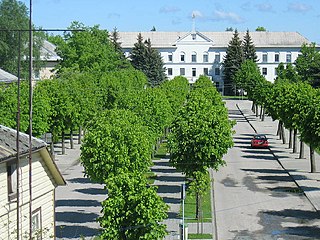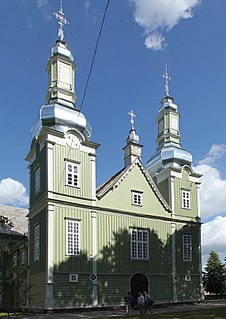
Šatrijos Ragana was the pen name of Marija Pečkauskaitė, a Lithuanian humanist and romantic writer and educator. Her most successful works are Sename dvare and Irkos tragedija.

Saliamonas Banaitis was a Lithuanian printer, politician, and businessman. He was one of the twenty signatories of the Act of Independence of Lithuania in 1918.

Marijampolė Rygiškių Jonas Gymnasium is a secondary school in Marijampolė, Lithuania. It is named after Rygiškių Jonas, one of the pen names of linguist Jonas Jablonskis who was one of the gymnasium's alumni. Established in 1867, the gymnasium was a significant cultural center of Suvalkija and educated many prominent figures of the Lithuanian National Revival. Since 2010, it is a four-year school.
Žiburėlis later Lietuvos žiburėlis was a charitable society providing financial aid to gifted Lithuanian students. The society grew out of the Lithuanian National Revival, hopes of creating Lithuanian intelligentsia, and frustration over financial hardships faced by many young students. It was established in 1893 by Gabrielė Petkevičaitė-Bitė and Jadvyga Juškytė, and led by Felicija Bortkevičienė from 1903 until its dissolution in 1940.
The Lithuanian Education Society Rytas was a Roman Catholic society fostering education in the Lithuanian language mostly in the Vilnius Region, then fiercely contested between Lithuania and the Second Polish Republic, now split between Lithuanian and Belarus. Established in 1913, the society maintained some 100 primary schools, 50 evening classes, Vytautas the Great Gymnasium and Teacher's Seminary in Vilnius in 1927. Due to political tensions between Poland and Lithuania as well as wider Polonization policies, Rytas faced increasing difficulties and restrictions in maintaining its schools. Similar situation existed with Polish schools in Lithuania. The situation continued to worsen as both sides increased restrictions in retribution. As schools were closed, Rytas shifted its focus to maintaining community reading rooms. After the death of Józef Piłsudski in 1935, the rooms were often raided by police and closed. Eventually, the society was abolished by Polish authorities in February 1938. Only the Vytautas the Great Gymnasium was allowed to operate. After the Polish ultimatum of March 1938, diplomatic relations were established between Poland and Lithuania and Rytas was allowed to operate again in May 1939. It could not resume its activities due to World War II and was abolished again soon after the occupation of Lithuania by the Soviet Union in June 1940. The society, with the same mission of promoting Lithuanian-language education, was reestablished in 2004.
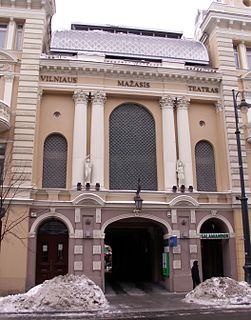
Rūta Society was a Lithuanian cultural society in Vilnius, then part of the Russian Empire, active from 1909 to the outbreak of World War I in 1914. It organized various events, including lectures, literary evenings, and musical performances, but it is most noted for its contribution to the development of the Lithuanian theater. In total, Rūta staged about 50 plays.
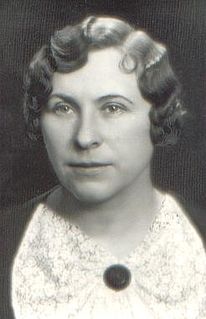
Magdalena GaldikienėnéeDraugelytė was a Lithuanian Catholic feminist, teacher, and politician. For two decades, she chaired the Lithuanian Catholic Women's Organization, the largest women's organization in interwar Lithuania. She was the first to celebrate the Mother's Day in Lithuania in 1928. She was elected to the Constituent Assembly of Lithuania in May 1920 and all subsequent Seimas (parliaments) until the 1926 coup d'état. After World War II, Galdikienė fled to United States where she devoted herself to supporting, promoting, and preserving the art of her husband painter Adomas Galdikas.
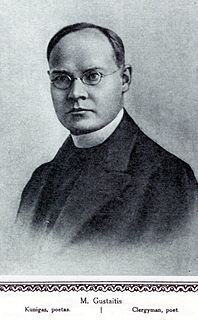
Motiejus Gustaitis was a Lithuanian Symbolist poet, who used numerous pseudonyms. He was also a translator and educator, as well as Catholic priest. A long-term chairman of the Žiburys Society, Gustaitis worked to establish Lithuanian schools and advocated girls' education. He worked as principal of girls' pro-gymnasium in Marijampolė and coed gymnasium in Lazdijai.
Tėvynės sargas was a Lithuanian-language periodical first established in 1896 in Tilsit, East Prussia during the Lithuanian press ban and the Lithuanian National Revival. It was published by the clergy and later by the christian democrats, thus it reflected and advocated for Roman Catholic ideals and values. Its motto was "All for Lithuania, Lithuania for Christ". With interruptions, it was published until 2000.
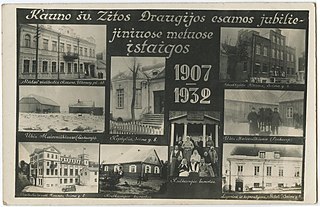
The Society of Saint Zita was a Lithuanian Catholic professional society of female servants and other workers active from 1905 to 1940. It was one of the first organizations of Lithuanian women. Its members were known as zitietės.

The Society of Saint Casimir was a Lithuanian society that published Lithuanian-language books and periodicals, many on Roman Catholic church and faith. Established in 1905, right after the Lithuanian press ban was lifted, the society published a total of about 740 books and several periodicals, including the first full Roman Catholic Bible translation into Lithuanian in six volumes in 1911–1937. From 1918 it operated its own printing press Šviesa. The society was liquidated after Lithuania was occupied by the Soviet Union in June 1940.

Julija "Julė" Pranaitytė was a Lithuanian newspaper editor, book publisher, and one of the first Lithuanian women travelers.
Antanas Milukas was a Lithuanian Roman Catholic priest, book publisher, and newspaper editor.
Motinėlė Society was the common name of two Lithuanian charitable societies, one based in United States and the other in Kaunas, Lithuania, that provided financial aid to gifted Catholic minded students. While the societies shared the name and functions, they were independent of each other. The Lithuanian American society was established in 1900 by a group of priests and was active until 1945. Lithuanian priests copied the example and established Motinėlė in Kaunas in 1903. This society was active until 1932. Both societies supported over 120 Lithuanian students, many of whom later became prominent figures in Lithuanian politics, science, culture, and Catholic church.

Vincentas Borisevičius was a Lithuanian Roman Catholic bishop of the Telšiai Diocese. The process of his canonization was initiated in 1990.
Lithuanian Catholic Academy of Science is an academic organization established in 1922 in Kaunas, Lithuania. It unites Catholic scientists from various fields, from humanities to astrophysics, and promotes academic research, organizes academic conferences, publishes academic literature. Its most active section is devoted to history, and in particular to the history of the Catholic Church in Lithuania. Other active sections include those devoted to humanities, education, and medicine. In 1922–2008, LKMA elected a total of 53 true academic members. Its main academic journals are LKMA suvažiavimo darbai, LKMA metraštis, and Bažnyčios istorijos studijos.

Pavasarininkai was the informal name for members of Pavasaris, a Lithuanian Catholic youth organization. It was active from 1912 to the Soviet occupation in 1940. It grew from various informal groups established around the Pavasaris magazine first published in May 1912. It was based in Kaunas, but most members were active in various rural location across Lithuania. With more than 90,000 members and 1,200 groups in 1940, it was one of the largest and most popular organizations in interwar Lithuania. Its motto was "For God and Fatherland" and it organized various events to educate the youth in the Catholic spirit and develop their national pride. Pavasarininkai were supported by local clergy and the Catholic hierarchy, but were frowned upon by the authoritarian regime of President Antanas Smetona. It was similar to and closely cooperated with the Catholic Youth Federation Ateitis.
The Lithuanian Scientific Society was a Lithuanian American society established by Jonas Šliūpas on 22 December 1889 in Baltimore, Maryland. It was one of the first non-religious organizations among Lithuanian Americans and promoted Lithuanian language and culture as well as the Lithuanian national consciousness. The society published books and two magazines – monthly Apšvieta and weekly Nauja gadynė. It was chaired by Jonas Šliūpas (1889–1891) and Ignas Bubelis (1892–1896) and was active until 1896. It was replaced by the Association of Lithuanian Patriots established by Tamošius Astramskas and active until at least 1970s.
